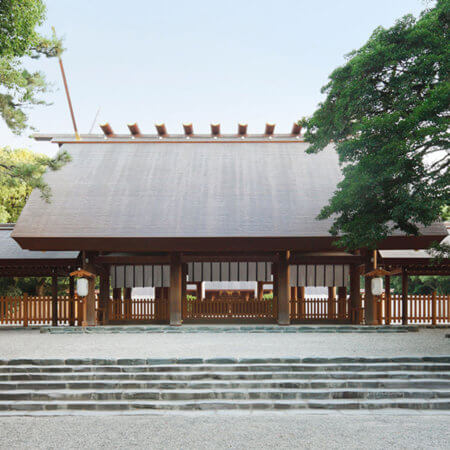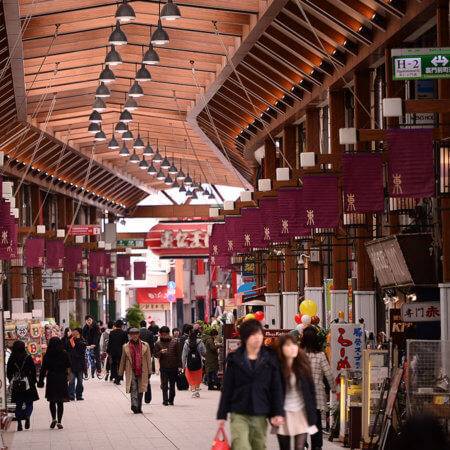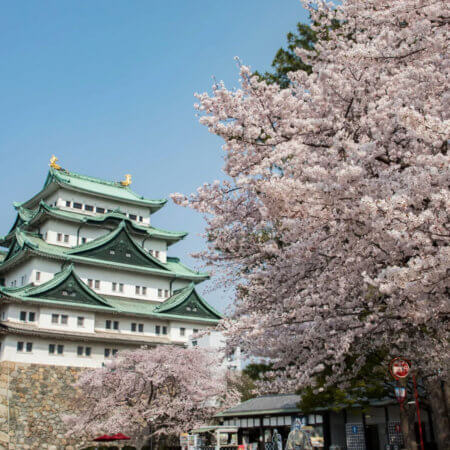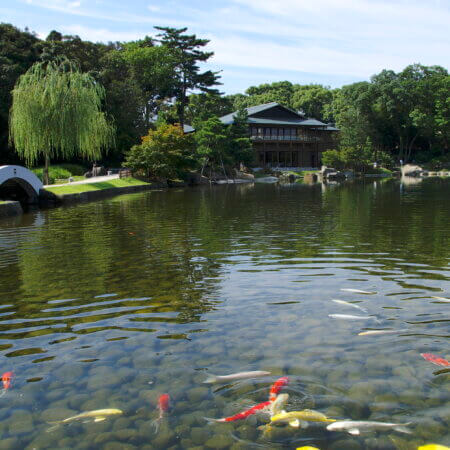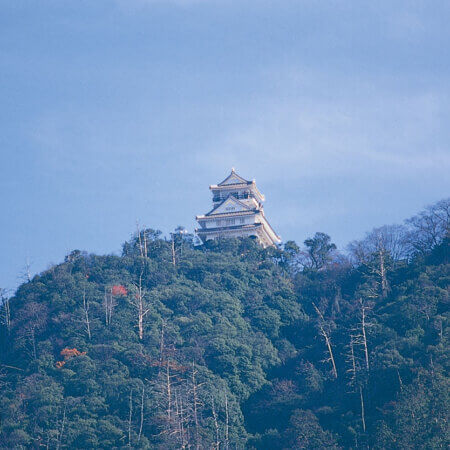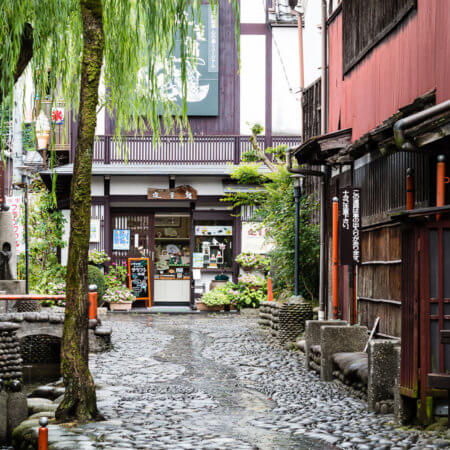【Atsuta Jingu (Atsuta Shrine)】It receives about 6.5 million visitors annually! A highly respected shrine since ancient times
- PREFECTURE
- AICHI
- INTEREST
- HISTORY
(Treasure Hall 09:00-16:30, last admission at 16:10)
(Treasure Hall is closed on the last Wednesday of every month and the following day, as well as from December 25 to December 31)
CONTENT
Attracting attention as a spiritual site

The shrine grounds have been known since ancient times as Kumomi-yama and Horai-no-shima, and despite being located in a large city, they offer surprising tranquility. Many people visit this oasis for healing and relaxation. The grounds cover an area of approximately 198,000 square meters, and when combined with other separate areas cover about 297,000 square meters. Taking the time to explore the area may purify both your mind and body.
In the divine garden, there are several trees estimated to be around a thousand years old. Some famous trees include the Narazu no Ume, a plum tree that blooms but does not bear fruit; the Taroan Tsubaki, a camellia tree loved by tea masters; and the Ookusu, a large camphor tree said to have been planted by Kobo Daishi. It might be a good idea to experience the grandeur of nature and the powerful energy of the plants found here.
Atsuta Shrine, celebrating its 1,900-year anniversary in the serene heart of the city

In 113 AD, when the legendary hero Yamato Takeru passed away in Ise province’s Nobono, the Kusanagi-no-Tsurugi sword was enshrined in Atsuta. Currently, the main deity of Atsuta Shrine is Atsuta-no-Ookami, with Amaterasu-Oomikami, Susanoo-no-Mikoto, Yamatotakeru-no-Mikoto, Miyasuhime-no-Mikoto, and Takeinadane-no-Mikoto enshrined as associated deities.
Atsuta-no-Ookami, also known as Amaterasu-Oomikami, is considered the ancestral deity of the imperial family and the most supreme and noble deity. This deity bestows compassionate virtues upon people and grants its vast divine virtues and blessings to all Japanese citizens. The shrine grounds include the main sanctuary, one separate sanctuary, eight branch shrines, and nineteen affiliated shrines. Including off-site shrines, there are a total of 45 shrines. The main sanctuary of the magnificent Atsuta Shrine is built in a style similar to that of Ise Grand Shrine, exuding an air of dignity and solemnity.
Please note that photography is prohibited on the stone steps. On the way to Hongu (Main Shrine), take a slight detour to the right to find the Shimizu-sha, where the deity of water resides. The spring water on the north side is believed to be good for the eyes and skin, so those with ailments may want to visit. Additionally, don’t miss the Sword Treasury, where you can view the historic Kusanagi-no-Tsurugi sword in a 270-degree semi-circular glass case.
After paying a visit, take a break with Nagoya’s Kishimen noodles and souvenir shops
One of the must-visit spots is Kusanagi Square, which evokes a nostalgic atmosphere. Boats and decks floating on the water, reminiscent of Atsuta Port, harmonize with the Minami-shinike pond, creating a unique ambience. There are benches around the pond under gazebos, offering a relaxing space to rest.
Don’t miss the delicious Kishimen noodles, a representative dish of Nagoya, served in the refreshing atmosphere surrounded by lush greenery. The history of Kishimen noodles dates back to the Edo period and is mentioned in multiple historical documents. The origin of the name is debated, with theories suggesting it comes from the use of pheasant (kiji) meat as an ingredient or that it was transmitted from Kishu. The flatness of the noodles is intriguing, but the thickness and width are only defined for dried noodles. As for fresh noodles, if they look like Kishimen and are flat, then they are considered acceptable.
The shape is designed to maximize the enjoyment of the rich, robust flavors characteristic of the Chubu region. Finally, be sure to visit the souvenir shops, where you can find unique items, such as tote bags with sword names, swprd scale models, and bookmarks with a sward letter opener. In addition, there are many food products, including Kishimen noodles, Kiyome mochi, Miyamanju, and roasted green tea, which convey the atmosphere of Atsuta Shrine.
Participate in festivals such as those heralding the arrival of summer in Tokai!
Atsuta Shrine holds around 70 festivals and rituals throughout the year, which is unique for its size. For example, the annual Hounensai Festival Hana no Tou on May 8 is an agricultural ritual to express gratitude for divine blessings and predict a bountiful harvest. Farmers predict the year’s crop yield based on the quality of the Otameshi decorations representing fields and rice paddies created at the Nishigakusho. The sight of the market selling vegetable seedlings and potted plants makes it impossible not to wish for the prosperity of farmers and happy meals on their tables every day.
The Atsuta Festival, held every June, is a major celebration at Atsuta Shrine, attended by imperial messengers sent by the Emperor. It is said to have originated in the mid-Heian period when a plague spread throughout the Owari region. When people prayed for the plague to subside, it did, and the locals began offering ceremonies. The festival is the most important and solemn among the shrine’s events, with dedicatory events held within the shrine grounds and fireworks in Jingu Park. From the evening, lanterns are lit at each gate, with 365 lanterns arranged in a hemisphere shape to represent the number of days in a year, and 12 lanterns attached to a pole at the top represent the months. The fantastical time spent praying for a year of good health is truly exceptional.
In addition to these events, numerous ceremonies such as martial arts, tea offerings, and flower offerings are held, attracting about 250,000 visitors. It is customary for locals to wear yukatas and carry fans in their hands while strolling around the stalls, adding a charming atmosphere to the festival.
AICHI
-
![【Laguna Ten Bosch】 Enjoy playing, eating, and shopping at this large-scale resort overlooking Mikawa Bay!]()
【Laguna Ten Bosch】 Enjoy playing, eating, and shopping at this large-scale resort overlooking Mikawa Bay!
-
![【Sakushima】A Charming Island of Healing and Art Floating in Mikawa Bay]()
【Sakushima】A Charming Island of Healing and Art Floating in Mikawa Bay
-
![Meet Japan’s Largest Pool and Approximately 500 Species, 50,000 Marine Creatures]()
Meet Japan’s Largest Pool and Approximately 500 Species, 50,000 Marine Creatures
-
![【Atsuta Jingu (Atsuta Shrine)】It receives about 6.5 million visitors annually! A highly respected shrine since ancient times]()
【Atsuta Jingu (Atsuta Shrine)】It receives about 6.5 million visitors annually! A highly respected shrine since ancient times
-
![【Osu Shopping Street】 The most energetic shopping district in Japan, with around 1,200 shops]()
【Osu Shopping Street】 The most energetic shopping district in Japan, with around 1,200 shops
-
![【Yabaton Yabacho Main Store】The go-to place for Nagoya’s famous Miso Katsu]()
【Yabaton Yabacho Main Store】The go-to place for Nagoya’s famous Miso Katsu
history
-
![【Nagoya Castle】A Castle with Deep Connections to Oda Nobunaga and Tokugawa Ieyasu]()
【Nagoya Castle】A Castle with Deep Connections to Oda Nobunaga and Tokugawa Ieyasu
-
![Drawing on history and tradition, the beauty of Japan at 【Tokugawa Park】]()
Drawing on history and tradition, the beauty of Japan at 【Tokugawa Park】
-
![【Inuyama Castle】Japan’s Oldest Surviving Castle Tower]()
【Inuyama Castle】Japan’s Oldest Surviving Castle Tower
-
![Watch from the stands as 1300 years of tradition unfold at the【Kiso River Ukai】]()
Watch from the stands as 1300 years of tradition unfold at the【Kiso River Ukai】
-
![The Headquarters of National Unification Surrounded by Nature【Gifu Castle】]()
The Headquarters of National Unification Surrounded by Nature【Gifu Castle】
-
![【Gujo Hachiman】A castle town known as the “Little Kyoto of Oku-Mino” with clear streams and famous spring water]()
【Gujo Hachiman】A castle town known as the “Little Kyoto of Oku-Mino” with clear streams and famous spring water




